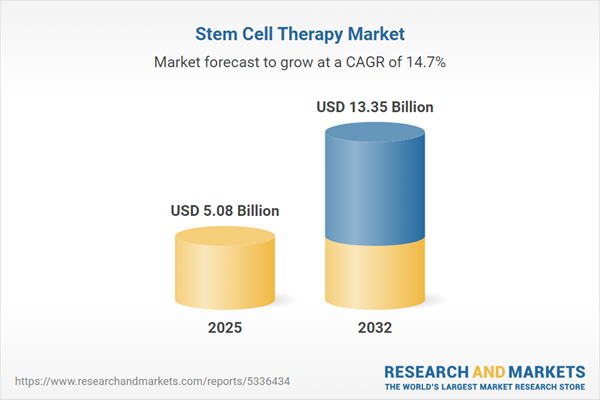Speak directly to the analyst to clarify any post sales queries you may have.
Senior leaders in life sciences face a shifting landscape as stem cell therapy evolves, requiring agile strategies for navigating complex regulatory, clinical, and operational environments. A targeted approach enables organizations to seize emerging opportunities, drive innovation, and sustain growth amid industry transformation.
Market Snapshot: Stem Cell Therapy Market Size and Growth
The global stem cell therapy market reached USD 4.45 billion in 2024 and is projected to expand to USD 5.08 billion in 2025, with a forecast value of USD 13.35 billion by 2032. This notable compound annual growth rate of 14.70% is propelled by ongoing advancements in gene-editing methods, increased clinical trial activity, and heightened investments from pharmaceutical and biotechnology sectors. Evolving regulatory frameworks have streamlined therapy approvals and accelerated time-to-market, while expanded technology adoption and new cross-regional alliances reshape how established and developing societies access stem cell solutions.
Scope & Segmentation in the Stem Cell Therapy Market
Thorough segmentation is essential for senior executives to commercialize breakthroughs, manage risk, and optimize returns in the stem cell therapy sector. The market’s structure includes multifaceted categories and operational pathways. Segment relevance is outlined for decision-making, resource allocation, and collaborative potential:
- Therapy Type: Includes allogeneic and autologous options, which inform evaluations around patient compatibility, treatment personalization, and supply implications.
- Cell Source: Captures adult, embryonic, induced pluripotent, and perinatal cell origins, each presenting distinct safety profiles, integration capabilities, and regulatory considerations.
- Technology: Covers biomaterial scaffolds, ex vivo expansion, and gene-editing methods, providing scalability and improved efficiency within therapeutic manufacturing and delivery pipelines.
- Mode of Administration: Considers intra-articular, intramuscular, and intravenous approaches, impacting operational logistics and influencing patient recovery experiences.
- Application: Explores usage across drug development, tissue engineering, and regenerative medicine, aligning scientific discovery with practical healthcare delivery.
- Therapeutic Areas: Spans cardiovascular, oncology, neurological, hematologic, and musculoskeletal disorders, uncovering key growth zones and partnership opportunities for resource allocation.
- End User: Incorporates academic institutions, healthcare systems, biopharma companies, and biobanks, building frameworks for collaboration, innovation, and data stewardship.
- Regions: Details North America, South America, Europe, Middle East, Africa, and Asia-Pacific, allowing teams to navigate regulatory frameworks and commercial conditions unique to each area.
- Companies Analyzed: Offers comparative industry player analyses, supporting strategic benchmarking and partnership planning for business leaders.
Key Takeaways for Senior Decision-Makers
- Integrating artificial intelligence with advanced gene-editing can accelerate therapy development and support faster clinical adoption, offering a distinct operational advantage.
- Maintaining a diverse technology portfolio and pursuing alliances across regions enables organizations to address shifting regulatory conditions and maintain flexibility in both mature and emerging markets.
- Staying current with evolving compliance standards reduces exposure to regulatory risk and supports sustainable domestic and global market participation.
- Optimizing resources within growth segments enhances resilience, ensuring operational continuity during market or demand fluctuations.
- Building targeted provider relationships and addressing local regulatory nuances streamlines administrative operations and increases the relevance and commercial impact of stem cell therapies.
- Bringing research, clinical, and technology leaders together improves data-driven decision-making and the effectiveness of patient-focused solutions.
Tariff Impact: Navigating 2025 U.S. Policy Shifts
Emerging U.S. biotechnology tariffs are forecast to raise expenses for raw material imports, directly affecting functions in stem cell therapy manufacturing and research. To address these challenges, many organizations are strengthening domestic sourcing and enhancing local manufacturing capacity. Forward-thinking supply chain management and regular risk assessment remain critical to protect against policy disruption and ensure continuous operations.
Methodology & Data Sources
This market research is based on insights from sector specialists, regulatory experts, and seasoned clinicians, incorporating information from scientific literature, regulatory publications, field case reviews, and expert-led workshops. The methodology ensures that findings are actionable, robust, and relevant for senior stakeholders.
Why This Report Matters
- Equips leaders with a clear understanding of market segmentation, supporting targeted investment and partnership decisions across geographies and business units.
- Delivers timely guidance on regulatory trends and supply chain dynamics that influence operational planning on a global scale.
- Enables executives to direct organizational research, guide commercialization strategies, and navigate regional expansion for positive market positioning.
Conclusion
This report provides focused strategic insight for executives managing innovation, risk, and operational performance as the stem cell therapy market expands and matures.
Additional Product Information:
- Purchase of this report includes 1 year online access with quarterly updates.
- This report can be updated on request. Please contact our Customer Experience team using the Ask a Question widget on our website.
Table of Contents
3. Executive Summary
4. Market Overview
7. Cumulative Impact of Artificial Intelligence 2025
Companies Mentioned
The companies profiled in this Stem Cell Therapy market report include:- BrainStorm Cell Therapeutics Inc.
- Merck KGaA
- Anterogen Co., Ltd.
- Astellas Pharma Inc.
- Beike Biotechnology Co., Ltd.
- Bristol-Myers Squibb Company
- CellProthera SAS
- Fate Therapeutics, Inc.
- Gamida Cell Ltd.
- Garuda Therapeutics
- Holostem Terapie Avanzate S.r.l.
- Jasper Therapeutics, Inc.
- JCR Pharmaceuticals Co., Ltd.
- Juvena Therapeutics Inc.
- Kangstem Biotech Co., Ltd.
- Kite Pharma, Inc. by Gilead Sciences, Inc.
- Lonza Group AG
- Medeze Group
- Mesoblast Ltd.
- Novo Nordisk A/S
- Plasticell
- ReNeuron Group PLC
- SQZ Biotechnologies Company by Stemcell Technologies
- Takara Bio Inc.
- Thermo Fisher Scientific Inc.
- U.S. Stem Cell Inc
- Umoja Biopharma
- Vericel Corporation
Table Information
| Report Attribute | Details |
|---|---|
| No. of Pages | 186 |
| Published | November 2025 |
| Forecast Period | 2025 - 2032 |
| Estimated Market Value ( USD | $ 5.08 Billion |
| Forecasted Market Value ( USD | $ 13.35 Billion |
| Compound Annual Growth Rate | 14.7% |
| Regions Covered | Global |
| No. of Companies Mentioned | 29 |









